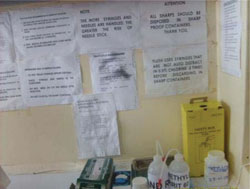26.2.2 Avoiding needle-stick injuries
A needle-stick injury refers to a healthcare worker accidentally puncturing their own skin with a needle that has previously been used to inject a patient. Needle-stick injuries can occur at any time, but they happen most frequently during and immediately after an injection is given. They can also occur when needles are not disposed of in safety boxes, for example when a healthcare worker picks up contaminated waste in which a needle has been left unnoticed.
In general, the more injection equipment that is handled, the greater the risk of needle-stick injuries. But these injuries are preventable. Box 26.1 lists the simple steps you can follow to reduce the risk of needle-stick injuries.
Box 26.1 Steps to reduce the risk of needle-stick injuries
- Handle needles and syringes as little as possible; avoid recapping the needle after use, and do not remove a used needle from the syringe.
- Handle needles and syringes safely; ensure you wear suitable gloves, and avoid recapping needles (Section 26.2.3 gives more details).
- Set up the injection preparation area so as to reduce the risk of injury. A safe work area for a clinic is shown in Figure 26.4.
- Position the patient, especially children, correctly for injections. (You will learn how to give injections via different routes of administration in the Module on Immunization, and in your practical skills training.)
- Place a safety box close to where the injections are being given, so that used syringes and needles can be disposed of immediately. Practise safe disposal of all contaminated sharps and waste.

26.2.1 Preparing to give an injection
